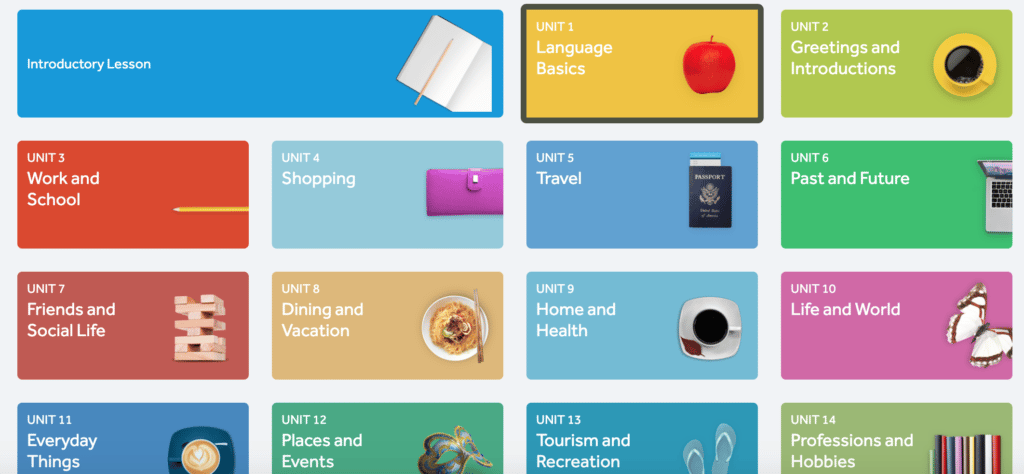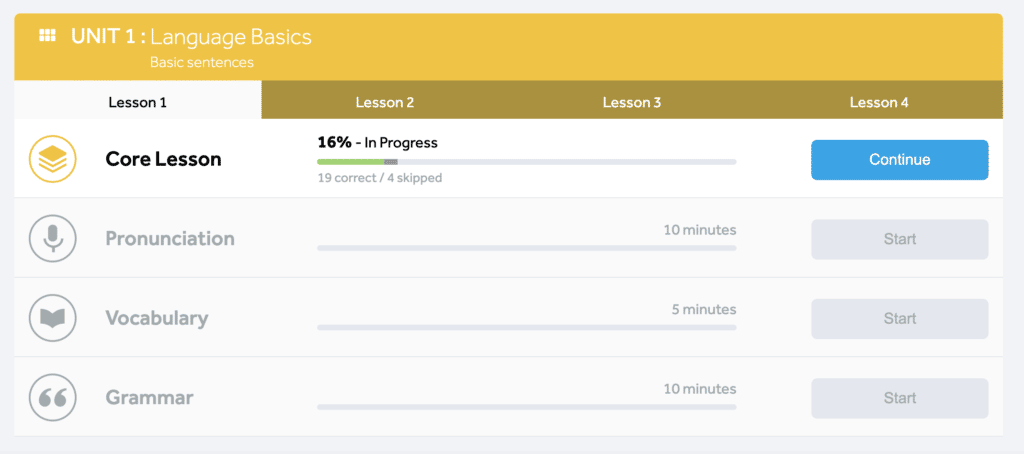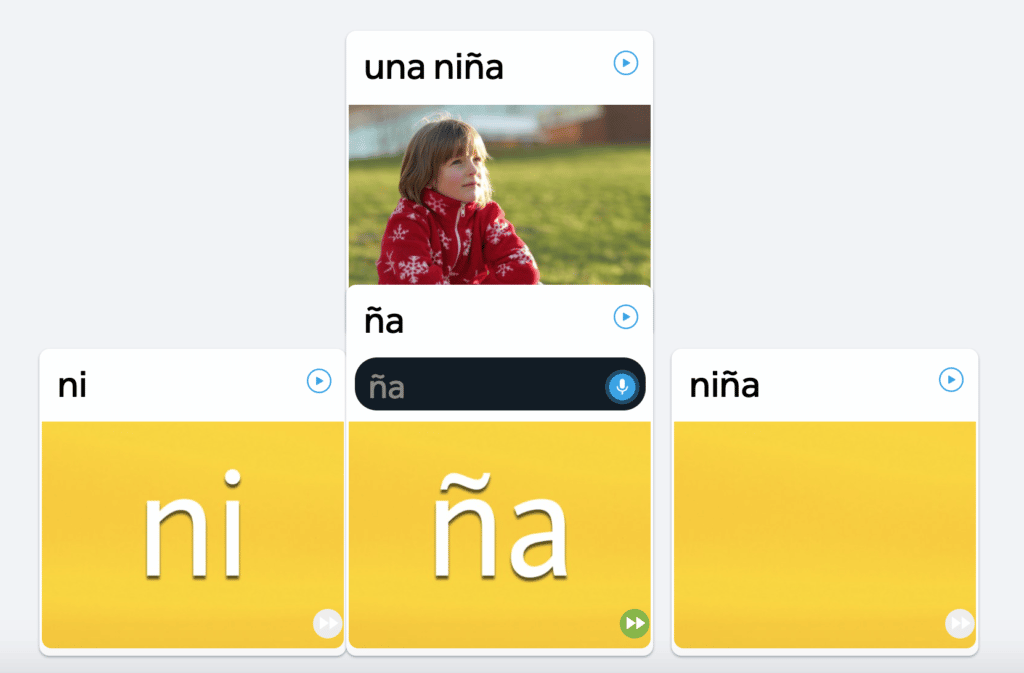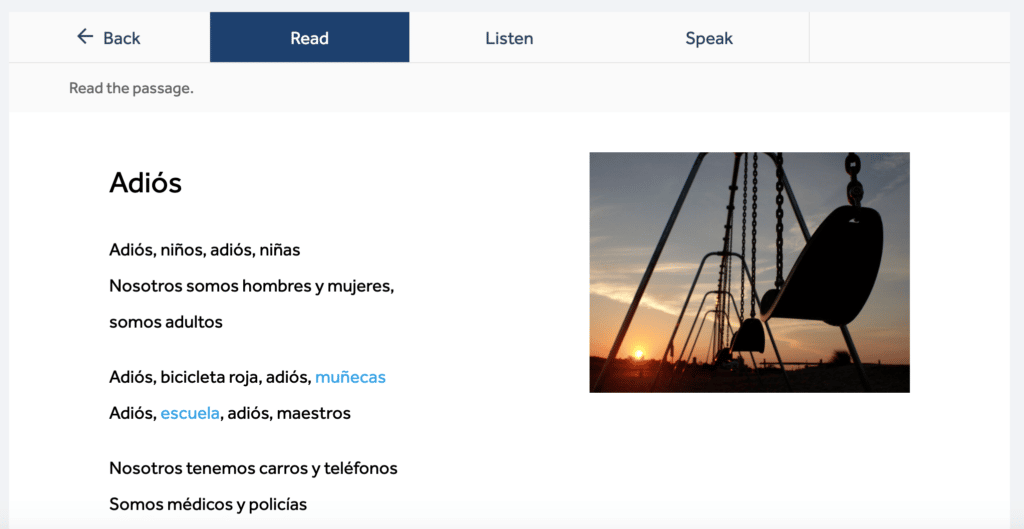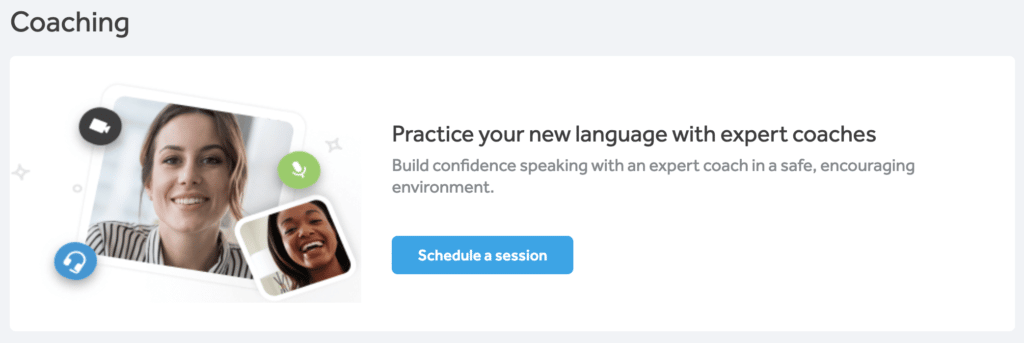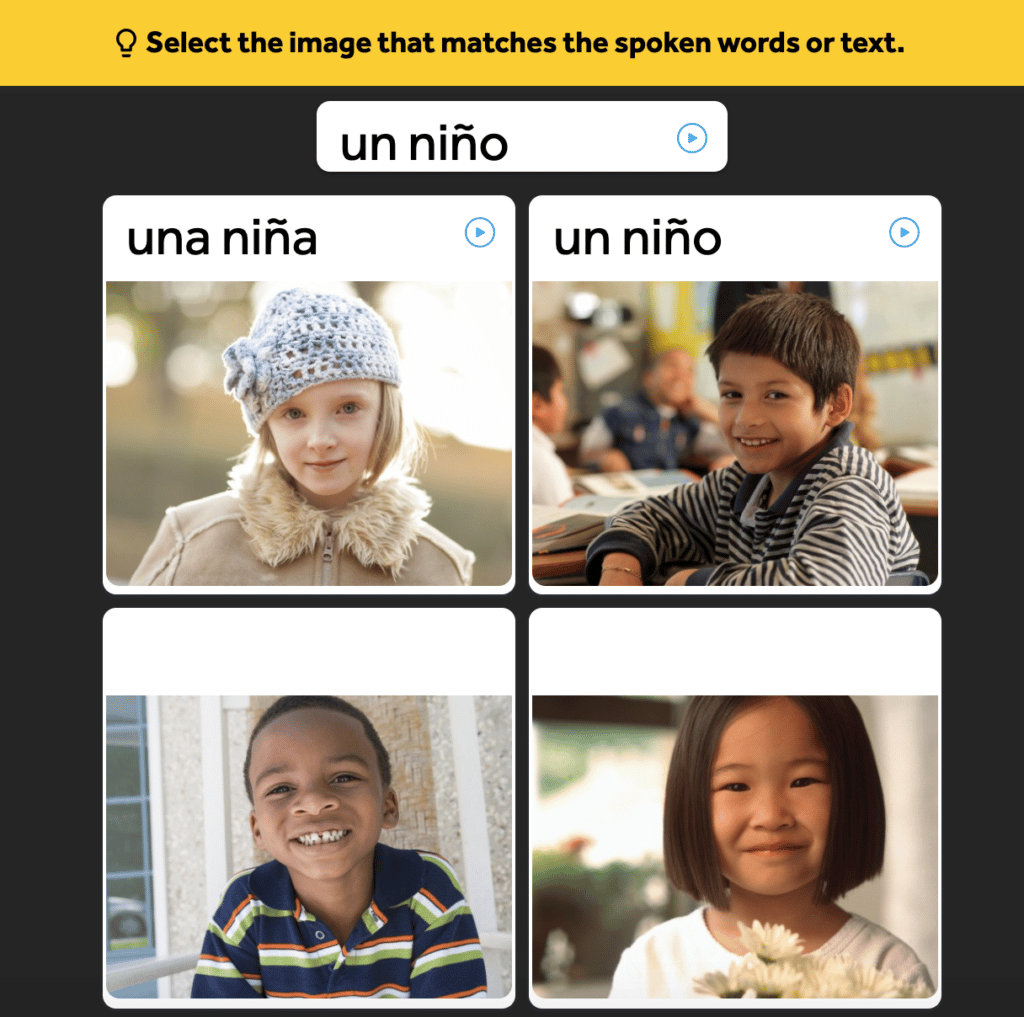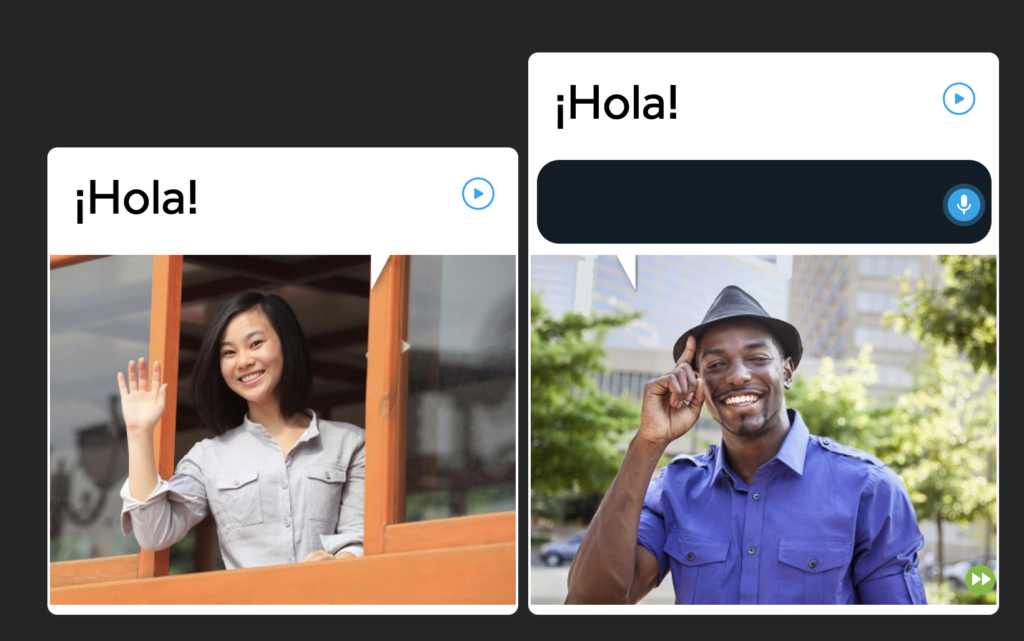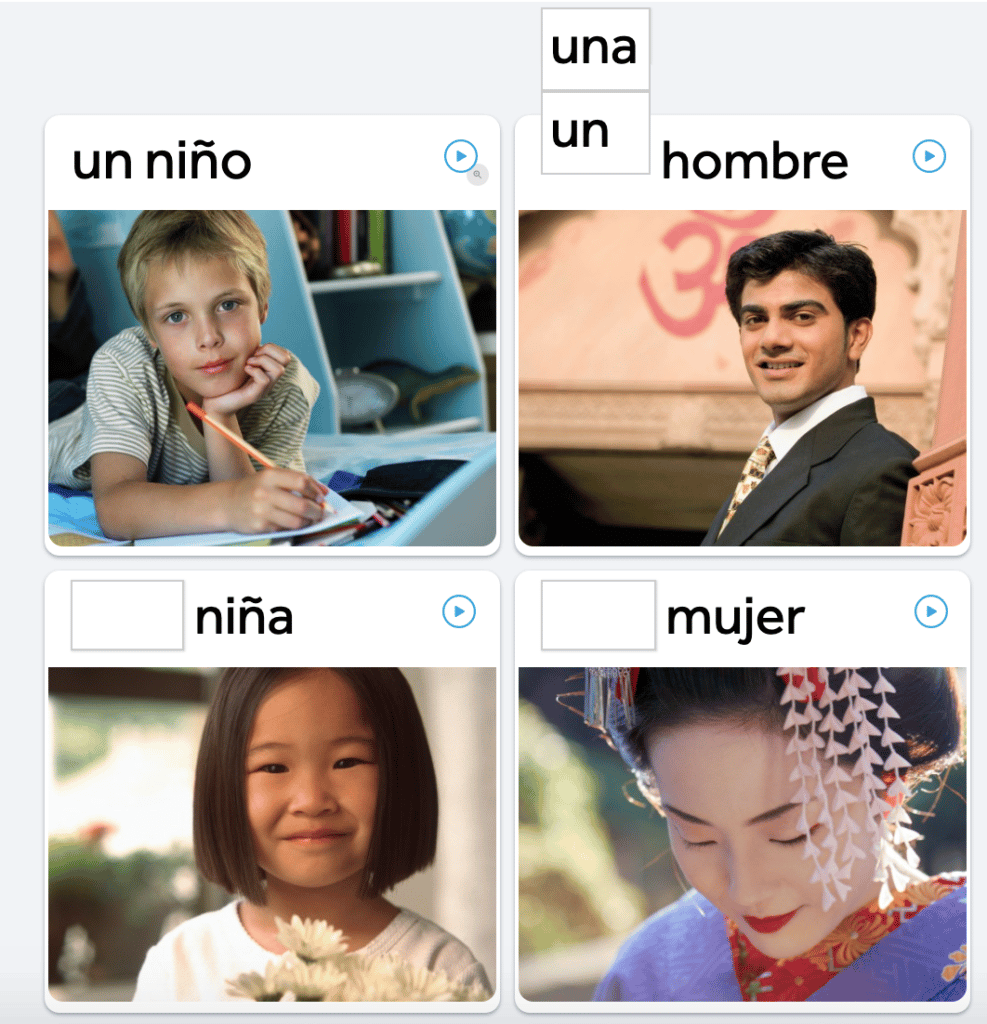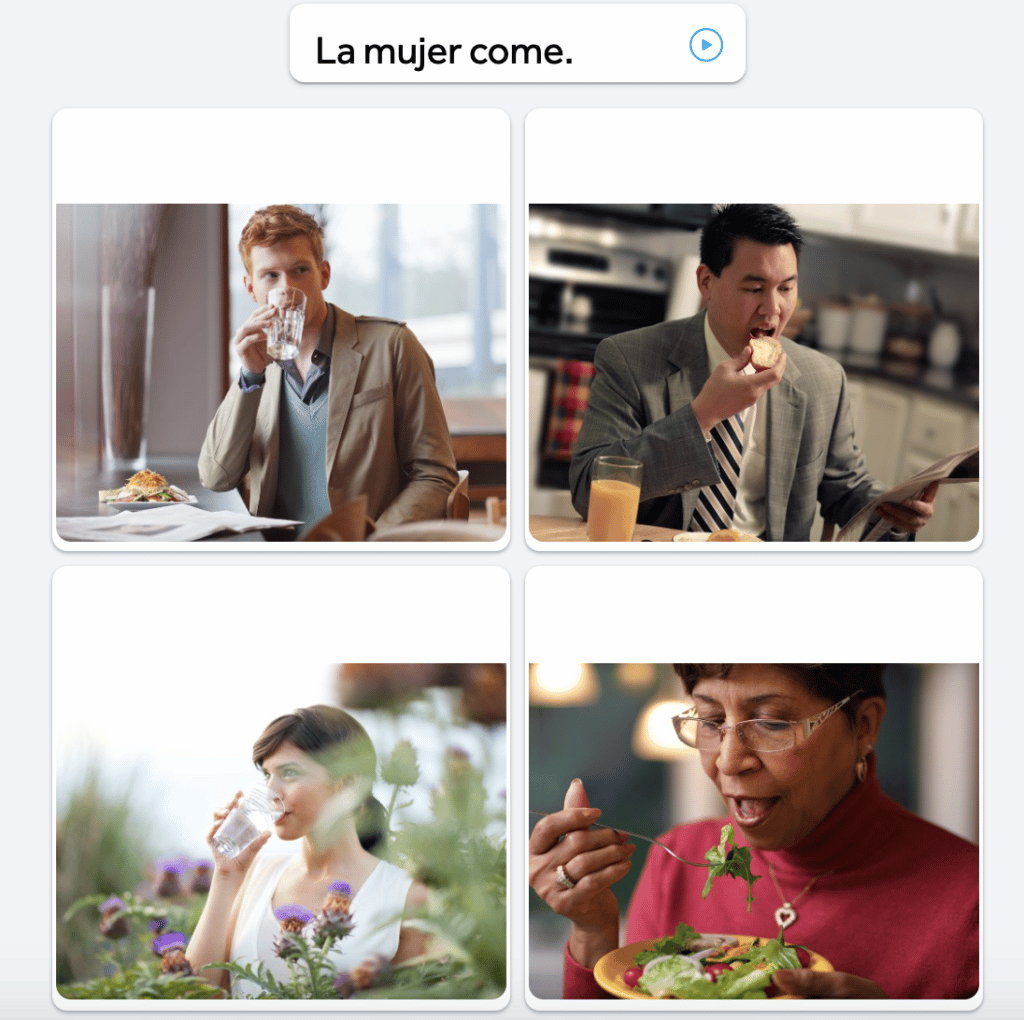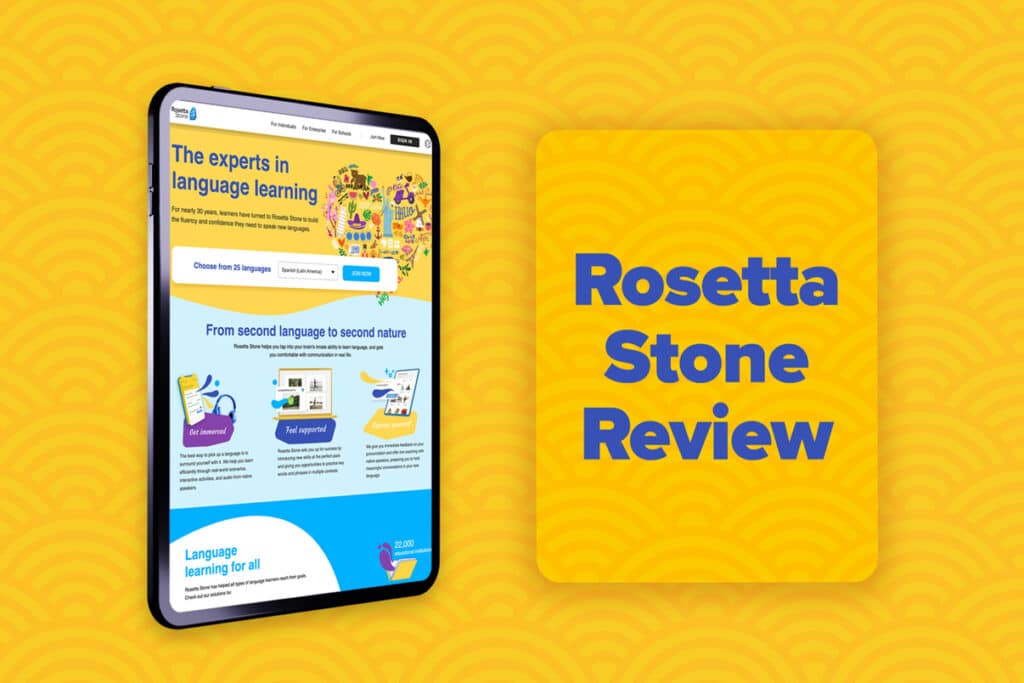
Full Rosetta Stone Review: Effective Legacy Program but Lacks Interactive Features
The Rosetta Stone language learning software became quite well-known for its unique language teaching capabilities, but critics often point to its inadequate techniques and somewhat high price.
Overall, I found that Rosetta Stone’s legacy is a double-edged sword. Despite its highlights and its effective teaching method, Rosetta Stone has serious gaps in its program that can hinder language learners, such as the lack of interactive features and explicit grammar instruction.
Read on for all the details and to find out if the program is worth it for you.
Overview

Name: Rosetta Stone
Description: A language learning software established in the 1990s.
Languages offered: 25 languages including Spanish, French, Japanese, Italian, Dutch, Arabic, Greek, Vietnamese and more.
Offer price: Monthly subscription from $15.99 per month
Summary
Rosetta Stone has been a language learning giant since the 1990s. Today, it continues its legacy with an updated interface and streamlined instruction, but falls short of providing a comprehensive language learning experience because it lacks interactive features and explicit grammar instruction.
- User friendliness - 7/107/10
- Delivers on promises - 8/108/10
- Authenticity - 6/106/10
- Value for price - 7/107/10
Pros
- Strong emphasis on common words and phrases
- Has speaking and pronunciation instruction
- Offers lessons with real native speakers of your target language
Cons
- Lacks explicit grammar instruction
- Not optimized for spontaneous language usage (like conversations)
- Exercises can get repetitive
Contents
- Rosetta Stone: A Brief Overview
- The Key Features of Rosetta Stone
- Rosetta Stone’s Positives
- Rosetta Stone’s Shortfalls
- How Does Rosetta Stone Compare to Competitors?
- How Much Does Rosetta Stone Cost?
- The Final Verdict on Rosetta Stone
- And One More Thing...
Download: This blog post is available as a convenient and portable PDF that you can take anywhere. Click here to get a copy. (Download)
Rosetta Stone: A Brief Overview
If you have ever considered learning a language, chances are you’ve heard of the language learning software called Rosetta Stone.
Often thought to be one of the first commercially-available language learning programs, Rosetta Stone was first developed in 1992 and released as a CD-ROM for computers in 1996.
At the time, it became the go-to software program for learning a language, with a near monopoly on language learning software. It brought language learning from language classes and university courses onto home computers, making it easy to learn a language in your spare time from the comfort of your home.
By the early 2010s, however, the digital language learning market had begun to change. Duolingo was released in 2011 to much fanfare, and language learning made the leap to app-based learning.
As such, Rosetta Stone had to adapt. After almost a decade as a CD-ROM, Rosetta Stone became available as a download and an online subscription in 2014.
In spite of this shift and in light of a rapidly changing market, Rosetta Stone remains one of the most popular language learning programs around.
Here’s an official Rosetta Stone video that shows how it works:
There are currently 25 languages available on Rosetta Stone, some with up to five individual courses per language. Some of the most sought-after languages include French, Spanish, Italian and Mandarin Chinese, but it also offers less-studied languages like Swahili, Tagalog and Indonesian.
The Key Features of Rosetta Stone
While the delivery format of Rosetta Stone has changed over the course of 30 years, its main features and teaching methods have remained fairly consistent. Let’s check them out.
Courses and Lessons
Rosetta Stone structures its offered languages as courses. Level 1 courses are for absolute beginners, and as the course number increases, so does the level of language mastery.
Some languages, like Latin American Spanish, have up to five levels, while other languages have just one or two levels.
Each course breaks down into a series of units. Each unit teaches vocabulary and grammar related to a certain topic, such as shopping, travel, home and health.
I found the unit lessons to be pretty straightforward. Rosetta Stone showed me various images and prompted me to match the picture with the word in my target language—in this case, Latin American Spanish.
Rosetta Stone calls this teaching method “Dynamic Immersion.” The theory is that the brain will make a strong association between the picture and the word in the target language, just like happens when you are a child learning your first language.
Rosetta Stone breaks down the lesson into multiple components. The “Core Lesson” focuses on introducing and reviewing new words and phrases. Other components of the lesson include “Pronunciation,” “Vocabulary” and “Grammar.”
Pronunciation and Reading Practice
While the “Vocabulary” and “Grammar” components feel like natural extensions of the “Core Lesson,” each lesson also includes pronunciation practice. I found this focus particularly useful for learners. We learn a language to speak it out loud, after all!
In the “Pronunciation” part of the lesson, Rosetta Stone had me speaking syllable-by-syllable, and I had to take the time to say each syllable carefully. After breaking each word or phrase down, Rosetta Stone put all the pieces together so I could practice pronouncing the whole word or phrase.
In addition to pronunciation practice, Rosetta Stone also offers “Stories” for learners. These are short stories that are completely in the target language. As I hovered my mouse over selected Spanish words, I got an instant English translation. This wasn’t available for all Spanish words—I only got a translation for the words that I didn’t learn in other Rosetta Stone lessons, which is quite clever, I thought.
I found it particularly useful that each story also has accompanying audio, recorded by a native speaker. There’s also the ability for you to record your own audio and then re-record it later as your accent improves.
Even though I find it a bit cringe-inducing to hear my own voice recorded, I found this feature genuinely helpful and I could hear my accent improving as I progressed, which made me feel great.
Learning with Human Support
I was delighted to discover that Rosetta Stone now offers learners the opportunity to interact with real humans! When I first tried the program many years ago, Rosetta Stone was a rather solitary experience: just me and the software. The option to talk with live native speakers is a welcome addition to the program.
I uncovered a couple of options for studying with real native speakers, all offered through a basic subscription to Rosetta Stone.
The first of these options are live lessons with native speakers. These lessons are livestreamed at a scheduled date and time, and they focus on a specific topic. I noticed that these occur pretty often and at various times. This would be a benefit for learners from multiple locations around the globe and with variable work or school schedules.
In addition to the live lessons, there are also short, on-demand videos about various topics. For example, you can check out pronunciation tips for sounding like a native speaker or learn some slang. These videos are pretty short — generally under five minutes.
I was surprised to discover that Rosetta Stone also offers language coaching. In essence, these are speaking practice sessions with a native speaker and language expert. Upon some digging, I figured out that you can book one session a week, and the session can have other learners in it. You can schedule a session at any time that works for you.
Authentic Native Material
Based on what we’ve seen so far, it should come as no surprise that all of Rosetta Stone’s learning material features native speakers.
This native language is present in all speech included in Rosetta Stone’s lessons, pre-recorded videos, stories and even through the inclusion of language coaches. In fact, Rosetta Stone’s “Dynamic Immersion” approach hinges on native speaker speech. Not to mention, I found that the speech is of high audio quality: crisp, clear and spoken slowly enough so you can catch everything.
In addition to audio, authentic native material is present in Rosetta Stone’s written offerings.
On-The-Go Audio Learning Capabilities
Lastly, I found it fantastic that lessons can be downloaded as audio-only files for on-the-go learning. This is perfect for learners who wish to learn while they commute or do chores around the house.
Rosetta Stone’s Positives
The question remains: Is Rosetta Stone any good? Is its reputation a result of its legacy or can it actually teach you a language? Let’s find out!
To start off, it is undeniable that there are quite a few things that Rosetta Stone does well.
Holistic Language Learning Program
First, I maintain that Rosetta Stone’s comprehensive courses can help you master all need-to-know words and phrases. Simply based on my experience with the level 1 Latin American Spanish courses, the focus was on the most common and most useful words. This will inevitably benefit my future interactions in Spanish and Rosetta Stone’s “Dynamic Immersion” method gives me the confidence needed.
Advanced Levels on Some Languages
Furthermore, some languages—such as Latin American Spanish—teach to quite advanced levels of the language. This course has five levels, so I could in theory reach a proficiency level of intermediate or high intermediate by the time I complete all five courses.
Native Audio, Video and Text
Next, Rosetta Stone’s inclusion of native audio, video and writing is invaluable to learners. While some language learning programs and apps opt for computer-generated voices—or no audio at all!—Rosetta Stone knows that to speak a language correctly, you need to hear it from the mouths of native speakers.
Effective Supplementary Lessons
Lastly, the supplementary features that Rosetta Stone offers are quite impressive. I was pleasantly surprised by the livestreamed lessons, videos, stories, pronunciation practice tools and language coaching. These all seem like recent additions, and they definitely enhance the core language learning program.
Rosetta Stone’s Shortfalls
While there have been sizable additions to Rosetta Stone since its release in the 1990s, there are still some shortcomings to the program.
Lack of Interactive Features
Rosetta Stone lacks meaningful interactive features. Sure, learners can match target language words to pictures, read and record their own audio, but I felt like there is not enough of a focus on spontaneous speaking and writing. Even the live lessons and the single weekly language coaching session seem a little lackluster.
Knowing that spontaneous speaking practice is crucial for building the skills needed for communicating with real native speakers, I couldn’t shake that Rosetta Stone almost treats it as an afterthought.
Listening Practice Lacking
Further, even listening practice is quite limited in the program. While I could listen to single words and phrases in the “Core Lesson” as well as recorded reading accompaniments, I couldn’t find comprehension practice for listening skills.
Even the pre-recorded videos are mostly English with some Spanish scattered throughout. This doesn’t really help develop spontaneous listening skills.
No Explicit Grammar Explanations
It also seems like a few key features are missing in the program. For starters, I noticed that there are no explicit grammar explanations. The “Grammar” tasks are mostly identification of patterns and recall, but I couldn’t find any written tutorials that actually explain grammar rules.
No Review Section
I couldn’t find a “review” feature of learned material anywhere! Perhaps it becomes available later on in the program, but the only method I could find to review lessons was to redo them.
How Does Rosetta Stone Compare to Competitors?
Let’s face it: this isn’t the 1990s, and Rosetta Stone isn’t alone in its field anymore.
The language learning market is changing daily, and new programs are being released all the time. So, how does Rosetta Stone hold up against its new peers?
Rosetta Stone vs. Pimsleur
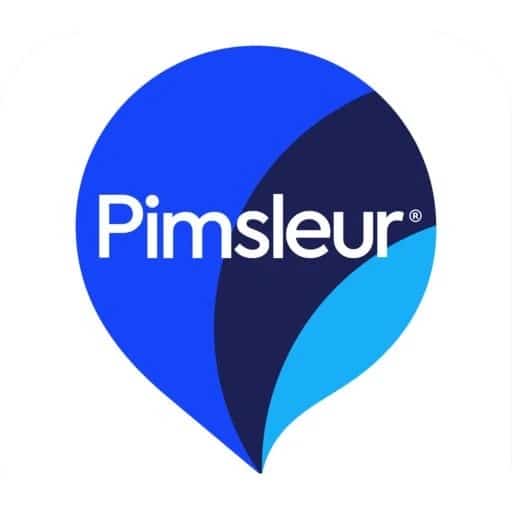
Pimsleur is another popular language learning program that’s been around for decades. But while Rosetta Stone uses a lot of visuals and interactive exercises, Pimsleur is almost completely audio-based.
Pimsleur mainly consists of longer audio lessons, with plenty of pauses where you’re prompted to say your own sentences out loud.
If you’re an auditory learner, then Pimsleur might work out great for you. Otherwise, Rosetta Stone is more well-rounded, with lessons on reading and writing too. Rosetta Stone is also more flexible when it comes to your pace of studying, unlike Pimsleur where ideally you listen to a lesson for 30 minutes every day.
Here’s our full review of Pimsleur.
Rosetta Stone vs. Michel Thomas
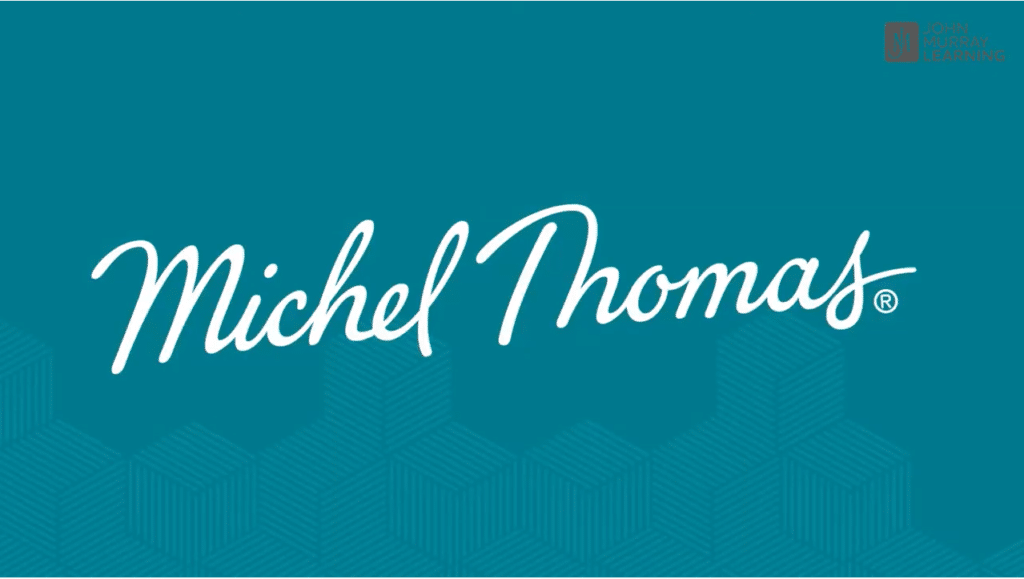
Like Rosetta Stone, Michel Thomas was a language learning pioneer. It’s an audio-based program, where each lesson features two students who are learning the language, with Michel Thomas as the teacher.
Surprisingly, Michel Thomas is better at training speaking skills rather than listening skills. If you want to start speaking faster, especially as a beginner, Michel Thomas does a better job. However, I would still say that Rosetta Stone is superior because it backs up its audio with different exercises.
Rosetta Stone is also more geared towards teaching you how to think in the language, compared to Michel Thomas where a lot of the explanations are in English.
Rosetta Stone vs. LingQ

LingQ is a more recent program that teaches you a language by immersing you in content. For example, the app lets you check the meaning of words in a story or article with a tap and even tracks how well you remember each word.
Both LingQ and Rosetta Stone use immersion, but I’d say that LingQ works better for serious learners, while Rosetta Stone is better for beginners or casual learners. In fact, you can do Rosetta Stone first to learn the fundamentals of the language, then add in LingQ once you’re at a more advanced level and ready to tackle native content.
Here’s our full review of LingQ.
Rosetta Stone vs. FluentU
For another style of doing immersion learning that focuses on video, there’s also FluentU. Compared to Rosetta Stone, learning a language this way can be more engaging because you’re watching authentic videos that native speakers actually watch and find interesting.
This is my personal favorite way of learning, partly because I’ve just heard so many non-native English speaking friends gush to me about how they learned English through watching soap operas and music videos and even skateboarding videos.
Also, the exercises in Rosetta Stone can get repetitive after a while, while learning with FluentU, you can easily pass hours at a time without even realizing you’re learning, but you are!
FluentU takes authentic videos—like music videos, movie trailers, news and inspiring talks—and turns them into personalized language learning lessons.
You can try FluentU for free for 2 weeks. Check out the website or download the iOS app or Android app.
P.S. Click here to take advantage of our current sale! (Expires at the end of this month.)
Rosetta Stone vs. Other Programs
- Price: Historically, Rosetta Stone has been quite expensive. I remember a single level of the software once costing hundreds of dollars. Today, however, it seems to have gone way down.
- Flashcards: As a flashcard or matching-based language learning program, I believe that Rosetta Stone is at the back of the pack. The truth is that flashcard-based apps like Duolingo and Memrise do the same job, basically for free.
- Well-rounded: As a well-rounded course, Rosetta Stone is middle of the road. There are definitely things that can be improved, but it does an okay job at what it offers. In fact, I think it is comparable to Babbel, give or take a few features.
That said, my opinion is that you can also go straight to a course specific to your target language. For example, a well-developed Pod101 course in Hindi may do a better job than Rosetta Stone at teaching Hindi specifically. Even a video, audio or written accompaniment course such as “Talk to Me in Korean” may do a better job than Rosetta Stone.
How Much Does Rosetta Stone Cost?
Rosetta Stone has no free features. Aside from a free trial, all other access is behind their paywall. During the trial, however, all features were available. So that is a great way to test out the program before committing.
If you decide to purchase, the program costs $15.99 a month for three months, or $13.99 a month for 12 months. This includes full access to one offered language.
There is an option, however, where users can buy a lifetime subscription to all languages for a one-time purchase of $399.
Here’s a link to Rosetta Stone’s pricing page.
The Final Verdict on Rosetta Stone
In my opinion, Rosetta Stone is worth it if you know what you’re paying for.
As an introduction to a language, or for informal study or travel purposes, Rosetta Stone is definitely worth a try. I believe you can learn quite a bit of a language with Rosetta Stone, and a single level would be enough to help you on a trip to a country where that language is spoken.
For serious learners, however, Rosetta Stone has some real limitations.
Learners looking for a more in-depth look at a language are better off with another language learning program or matching Rosetta Stone with supplementary materials.
The most glaring omission is Rosetta Stone’s lack of grammar tutorials, so I would recommend an in-depth grammar resource. And don’t forget real opportunities for spontaneous speaking and writing practice. This can be found through services like italki or by meeting native speakers locally.
The elephant in the room also is that there are definitely cheaper and even free options available that can give you what Rosetta Stone offers. These options may be less well-rounded than Rosetta Stone, and a well thought out learning plan including multiple programs could lead to better results.
Like the real Rosetta Stone which sits in the British Museum in London, Rosetta Stone once changed the world. Over the past 30 years, it has adapted to new technologies and competitors. While it holds its own right now, without meaningful changes to some of its available features, it may not last another 30 years.
And One More Thing...
If you dig the idea of learning on your own time from the comfort of your smart device with real-life authentic language content, you'll love using FluentU.
With FluentU, you'll learn real languages—as they're spoken by native speakers. FluentU has a wide variety of videos as you can see here:
FluentU has interactive captions that let you tap on any word to see an image, definition, audio and useful examples. Now native language content is within reach with interactive transcripts.
Didn't catch something? Go back and listen again. Missed a word? Hover your mouse over the subtitles to instantly view definitions.
You can learn all the vocabulary in any video with FluentU's "learn mode." Swipe left or right to see more examples for the word you’re learning.
And FluentU always keeps track of vocabulary that you’re learning. It gives you extra practice with difficult words—and reminds you when it’s time to review what you’ve learned. You get a truly personalized experience.
Start using the FluentU website on your computer or tablet or, better yet, download the FluentU app from the iTunes or Google Play store. Click here to take advantage of our current sale! (Expires at the end of this month.)
